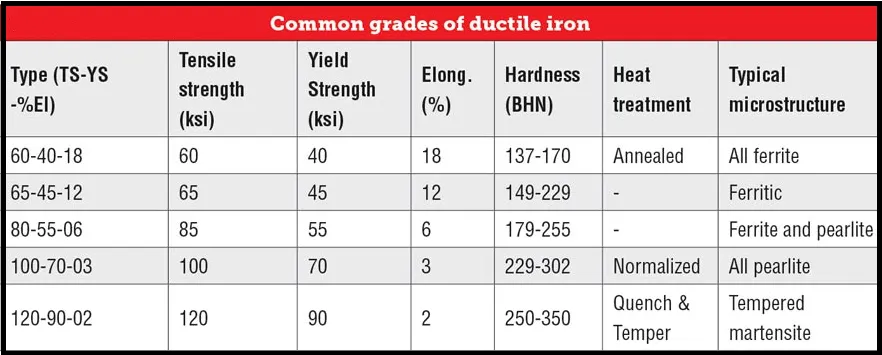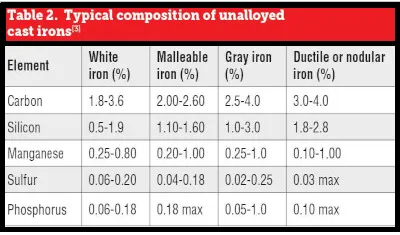Cast iron has been a vital material in various industries for centuries, owing to its exceptional strength, durability, and heat resistance. However, to fully harness its potential, cast iron often undergoes a crucial process known as heat treatment. In this article, we will learn different types of heat treatment for cast iron, exploring its benefits, methods, and applications.
What is Cast Iron?
Cast iron is a type of iron alloy that contains a high amount of carbon (typically between 2% and 4%). It is known for its excellent heat retention and distribution properties, making it suitable for various applications.
Cast iron is produced by melting iron and adding carbon-rich materials, such as coke or charcoal, to the molten iron. The resulting alloy is then poured into molds to create various cast iron products, such as cookware, pipes, engine blocks, and decorative items.
Types of Cast Iron
There are several types of cast iron, each with its own unique properties and applications. Here are some common types of cast iron:
- Gray Cast Iron: This is the most widely used type of cast iron. It has a grayish appearance due to the presence of graphite flakes in its microstructure. Gray cast iron is known for its good thermal conductivity, high damping capacity, and excellent machinability. It is commonly used in engine blocks, pipes, and automotive components.
- White Cast Iron: White cast iron has a white, crystalline appearance due to the absence of graphite. It is extremely hard and brittle, making it suitable for applications requiring high wear resistance, such as grinding balls and mill liners.
- Ductile Cast Iron: Also known as nodular cast iron or spheroidal graphite iron, ductile cast iron contains spherical graphite nodules instead of flakes. This gives it improved ductility and toughness compared to gray cast iron. Ductile cast iron is commonly used in applications that require high strength, such as crankshafts, gears, and heavy machinery components.
- Malleable Cast Iron: Malleable cast iron is produced by heat-treating white cast iron, which converts the carbon in the microstructure into graphite clusters. This process imparts improved ductility and toughness to the material. Malleable cast iron is used in applications that require good shock resistance, such as pipe fittings and agricultural equipment.
- Compacted Graphite Iron: Compacted graphite iron (CGI) has a microstructure that is intermediate between gray cast iron and ductile cast iron. It contains graphite in the form of compacted nodules, which provide a good balance of strength, thermal conductivity, and wear resistance. CGI is commonly used in automotive applications, such as cylinder heads and brake rotors.
Cast iron grades refer to specific compositions and properties of cast iron that meet certain industry standards. Some common cast iron grades include:

- ASTM A48: This standard covers gray iron castings for general engineering purposes.
- ASTM A536: This standard covers ductile iron castings for various applications.
- ASTM A197: This standard covers malleable iron castings for high-temperature service.
- ASTM A439: This standard covers austenitic ductile iron castings for corrosion-resistant applications.
Chemical compositions of various types of cast iron are given in below table:

Heat Treatment of Cast Iron
Stress Relief Heat Treatment of Cast Iron
Managing Internal Stress To address internal stress in castings caused by complex shapes or drastic changes in cross-sectional area, stress relief is necessary. The time-temperature relationship is crucial, and higher temperatures may require protective atmospheres to prevent oxidation.
The recommended soak time at temperature is approximately 1.5 hours per 25.4 mm (1 inch) of cross-sectional area for sections over 50 mm (2 inches), and 1 hour per 25.4 mm (1 inch) for thinner sections. Cooling rates also play a role, with furnace cooling to 260°C (500°F) generally sufficient, but intricate shapes requiring cooling to 95°C (200°F).
You can follow below heat treatment cycle for cast iron Stress Relief Heat Treatment:
- Load the furnace
- Maintain furnace temperature below 100°C
- Heat the furnace to 510-650°C within approximately 3 hours
- The stress relieving temperature is determined by the composition of the grey iron or as agreed upon by the manufacturer and purchaser
- Hold the furnace at that temperature for 1 hour
- Cool the furnace to 200°C-300°C
- Finally, allow the furnace to air cool.
Annealing Heat Treatment of Cast Iron
Enhancing Machinability and Properties Annealing is employed to improve the machinability of castings by softening the material. Ductile iron, in particular, can experience increased ductility and impact resistance through annealing. Different heating and cooling cycles can be utilized, each serving a specific purpose.
Normalizing Heat Treatment of Cast Iron
Achieving Desired Microstructure Normalizing is commonly performed on iron castings to obtain a fine pearlite microstructure, resulting in enhanced tensile strength and wear resistance. The heating rate is generally not critical, but precautions must be taken to prevent excessive distortion and cracking.
The normalizing temperature ranges vary depending on the type of cast iron, with cooling rates ranging from still-air to fan-assisted cooling for larger castings. Tempering may be necessary if the final hardness is too high.
Hardening (Quench and Temper) Heat Treatment of Cast Iron
Careful Process Control When hardening cast irons, it is crucial to select and control process parameters to avoid issues such as distortion, warpage, overheating, or quench cracking. The lower-critical temperature for cast irons can be calculated or determined through sample analysis.
The typical practice involves austenitizing the castings at a temperature 10-38°C (50-100°F) above the upper-critical temperature for one hour per 25 mm (1 inch). Gradual heating is recommended to prevent thermal stresses.
After soaking, the parts are quenched, and a severe quench is often unnecessary. Oil or polymer quenching methods can also be employed. Tempering follows, allowing for the development of desired mechanical properties over a wide temperature range. Tempering time is typically shorter than that for steels.
Cryogenic Processing Heat Treatment of Cast Iron
Enhancing Microstructure and Properties Cryogenic treatment, involving extremely low temperatures (-195˚C/-320˚F), is utilized to stabilize the microstructure and improve properties such as dampening and wear characteristics.
The process involves gradually reducing the temperature, stabilizing at the low temperature for a period, and then slowly raising the temperature back to room temperature. Cryogenically treated gray cast-iron brake rotors have demonstrated improved service life in automotive applications.
For instance, in police cars, cryogenic treatment has extended the time between brake-component replacements from around 12,875 km (8,000 miles) to consistently up to 38,625 km (24,000 miles), due to the combination of high speeds and frequent braking.
Benefits of Heat Treatment for Cast Iron:
- Increased Strength: Heat treatment significantly improves the strength of cast iron, making it more resistant to deformation and wear. This is achieved by transforming the microstructure of the material, resulting in a more uniform and refined grain structure.
- Enhanced Hardness: Heat treatment can increase the hardness of cast iron, making it suitable for applications that require resistance to abrasion and wear. This is achieved by transforming the carbon in the material, forming hard carbides that contribute to its overall hardness.
- Improved Toughness: Heat treatment can also enhance the toughness of cast iron, making it less prone to cracking or fracturing under impact or heavy loads. By controlling the cooling rate during heat treatment, the material’s microstructure can be optimized to improve its toughness.
Applications of Heat-Treated Cast Iron:
- Automotive Industry: Heat-treated cast iron is widely used in the automotive industry for engine components, such as cylinder blocks, cylinder heads, and crankshafts, due to its excellent strength, wear resistance, and thermal stability.
- Construction Industry: Heat-treated cast iron finds applications in the construction industry for manufacturing heavy machinery components, such as gears, pulleys, and structural parts, where high strength and durability are essential.
- Tooling and Machinery: Heat-treated cast iron is extensively used for producing tools, dies, and molds due to its exceptional hardness, wear resistance, and dimensional stability.
